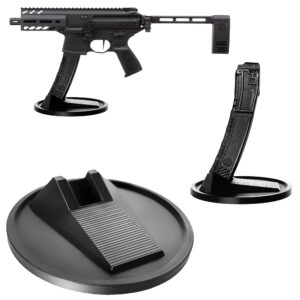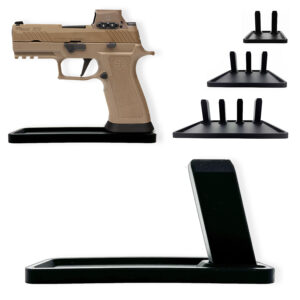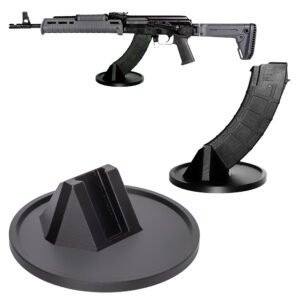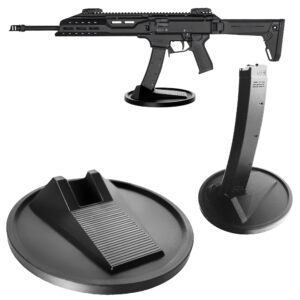
Categories:
When it comes to enhancing the performance and handling of an AR10 rifle, one of the key components that often garners attention is the muzzle device. An essential accessory attached to the end of the barrel, a muzzle device can play a significant role in managing recoil, reducing muzzle flash, and controlling muzzle rise—which altogether influence the shooter’s overall experience and effectiveness.
Understanding how an AR10 muzzle device functions begins with recognizing the basics of firing dynamics. When a shot is fired, the rapidly expanding gases propel the bullet out of the barrel, but they also generate substantial backward force, leading to recoil. Additionally, these gases exiting the muzzle can create a visible flash and cause the barrel to rise. Different muzzle devices are meticulously engineered to address these specific challenges.
A common type of muzzle device is the muzzle brake, designed primarily to reduce recoil. It works by redirecting the gases sideways or backward, countering the force that pushes the rifle rearward. By mitigating this backward pressure, the shooter can achieve more stability, quicker target reacquisition, and maintain better accuracy for consecutive shots.
On the other hand, to minimize the visible flash that can impair night vision and give away positions, a flash suppressor or flash hider is employed. These devices disperse the exiting gases in such a way that the flash produced when firing is significantly reduced. The flash reduction is not just cosmetic but can be a crucial tactical advantage in low-light or night-time shooting scenarios.
The third prevalent type of muzzle device is the compensator, which addresses muzzle rise. It features ports or baffles on the top or sides that vent gases in such a way that they counteract the upward motion of the barrel. This assists in maintaining a level barrel, allowing for quicker follow-up shots and better control during rapid fire.
Many modern muzzle devices offer a combination of these benefits, such as hybrid models that function as both compensators and flash suppressors. Selecting the right muzzle device depends on the specific needs and preferences of the shooter. Whether the focus is on reducing recoil, minimizing muzzle flash, or controlling muzzle rise, an appropriate muzzle device can significantly enhance the performance and handling of an AR10 rifle, making the shooting experience more effective and enjoyable.
Muzzle devices for the AR10 rifle, a powerful and versatile gun often used in tactical, hunting, and competitive shooting scenarios, are designed to address various aspects of its performance, such as recoil management, flash concealment, and muzzle rise reduction. These devices can be broadly grouped into three primary categories, each with a specific focus but sometimes overlapping in function: compensators, muzzle brakes, and flash suppressors.
Compensators are designed to mitigate muzzle rise, a phenomenon where the barrel moves upwards after a shot is fired due to the force of the recoil. This upward movement can significantly affect accuracy, especially during rapid fire. Compensators typically feature top and side ports that redirect the gases expelled from the barrel to counteract the upward force, keeping the muzzle steadier and allowing for quicker follow-up shots.
This type of device is particularly popular among competitive shooters who require precision and rapidly successive shots.
Muzzle brakes, on the other hand, primarily address the issue of recoil. Recoil can be quite substantial with high-powered rifles like the AR10, potentially causing discomfort and affecting accuracy over prolonged shooting sessions. Muzzle brakes function by redirecting the gases produced when firing to the sides, thereby countering the backward force generated by the bullet’s propulsion. This redirection of energy can significantly reduce the felt recoil, making the rifle easier to handle and improving the shooter’s ability to stay on target.
Flash suppressors or flash hiders focus on minimizing the visible muzzle flash that occurs when a gun is discharged. The bright flash of light can be disorienting, particularly in low-light conditions, and can also reveal the shooter’s position in tactical scenarios. Flash suppressors work by dispersing the gases emitted at the muzzle in multiple directions, reducing the brightness and visibility of the flash.
This not only preserves the shooter’s night vision but also helps maintain an element of stealth.
Some AR10 muzzle devices are hybrids, combining features of compensators, muzzle brakes, and flash suppressors to offer a more comprehensive solution. These hybrid devices aim to provide balanced performance across recoil reduction, muzzle rise control, and flash suppression, offering an all-in-one solution for shooters who prioritize versatility.
Ultimately, the choice of a muzzle device for an AR10 depends largely on the shooter’s specific needs and preferences, whether it be for competitive accuracy, tactical advantage, or overall shooting comfort and control.
When it comes to the AR-10, the effectiveness of muzzle devices in affecting recoil can profoundly enhance shooting performance and overall gun control. Recoil, essentially the rearward motion experienced when a gun is discharged, can impact both accuracy and the shooter’s comfort. Different muzzle device designs aim to mitigate this force, offering variable results based on their inherent mechanisms and construction.
One of the primary types of muzzle devices used to control recoil is the muzzle brake. Muzzle brakes operate by redirecting propellant gases to counteract the gun’s backward momentum. Typically, they feature ports or baffles strategically positioned to deflect escaping gases in multiple directions. This redirection generates a forward thrust that opposes the backward force of recoil. By reducing the felt recoil, muzzle brakes improve shooter stamina, accuracy, and rapid follow-up shot capability.
For the AR-10, known for its robust caliber options, an effective muzzle brake can translate to more manageable shooting sessions, making high-volume firing sequences far less strenuous.
Another category of muzzle devices includes compensators, which, while primarily designed to control muzzle rise, can also contribute to recoil reduction indirectly. Compensators work by venting gases primarily upward, pushing the barrel downwards. Although their main objective is to reduce muzzle climb, the alteration of gas dynamics also alleviates some of the rearward thrust, thus aiding in recoil mitigation. However, their efficacy in reducing recoil is often less pronounced compared to dedicated muzzle brakes.
Hybrid devices combining characteristics of brakes and compensators attempt to offer a balanced solution, mitigating both recoil and muzzle rise. These hybrid designs work by utilizing both side and top ports, providing a comprehensive approach to gas management. For AR-10 users seeking versatile performance, hybrid devices can deliver effective recoil reduction while maintaining control over muzzle movement.
The material and overall design quality of these devices play critical roles in their effectiveness. Constructed from durable materials like stainless steel or titanium, high-quality muzzle devices ensure longevity and consistent performance. Furthermore, customized designs tailored specifically to the AR-10 platform can offer enhanced compatibility and efficiency.
In conclusion, the selection and application of muzzle devices on the AR-10 significantly influence recoil management, directly impacting shooting comfort and accuracy. Whether opting for a dedicated muzzle brake, a compensator, or a hybrid device, understanding their respective advantages empowers users to optimize their gun’s performance and shooting experience.
Muzzle devices play a critical role in the performance of any gun, including the AR-10, particularly when it comes to controlling flash suppression. Flash suppression is essential for various reasons, including preserving night vision, reducing the shooter’s visibility to others, and preventing the disorientation that can occur from the intense bright light emitted by the muzzle blast.
The primary function of a flash suppressor is to serve as a barrier to the gases that escape after a bullet exits the barrel. When a projectile is discharged, it creates a rapid expansion of super-heated gases that escape into the atmosphere, causing a bright flash. This phenomenon is especially pronounced in high-caliber guns like the AR-10 due to the significant volume of propellant gases involved.
A flash suppressor mitigates this by dispersing the gases in a way that reduces the intensity and visibility of the flash.
Flash suppressors often feature ported designs that carefully direct the exiting gases in multiple directions. By doing so, they increase the surface area over which the gases can cool and dissipate, significantly reducing the visible flare. The design might include prongs, cuts, or other features that break up the gas flow, diminishing the formation of a single, bright flash. In effect, a well-engineered flash suppressor can almost entirely hide the muzzle flash from the naked eye, which is particularly advantageous in low-light conditions or night-time operations.
Another benefit of effective flash suppression is the reduction in the shooter’s signature. For military or tactical shooters, minimizing this flash can be vital for maintaining stealth and evading enemy detection. Law enforcement and civilian shooters also benefit from reduced visibility in training scenarios and home defense situations. Furthermore, controlling the flash can also improve follow-up shot accuracy by reducing the temporary blindness and disorientation that can impact the shooter after each shot.
However, it is worth noting that while flash suppressors are highly effective in reducing visible light, they do not offer as much in terms of recoil reduction or controlling muzzle rise as other specific types of muzzle devices. Therefore, for users looking to manage recoil or muzzle climb, flash suppressors are often used in conjunction with other specialized devices like compensators or muzzle brakes to achieve an all-encompassing effect on the gun’s overall performance.
Nonetheless, the importance of flash suppressors in enhancing shooter safety, maintaining tactical advantage, and improving shooting comfort remains undeniable.
Mitigating muzzle rise in an AR-10 rifle involves careful selection of an appropriate muzzle device. Muzzle rise, also known as muzzle climb, occurs when the barrel of the rifle lifts upwards after a shot is fired. This phenomenon is influenced by the forces exerted when the bullet exits the barrel and the expanding gases follow it. These gases exert pressure in all directions, pushing the muzzle upwards and impacting the shooter’s ability to maintain aim and quickly acquire the next target.
To address this, different types of muzzle devices have been developed, each with a unique mechanism to counteract these forces and improve shooting stability.
One of the primary devices used to mitigate muzzle rise is the compensator. Compensators work by redirecting the escaping gases in a way that counters the upward force. Typically, they have ports or vents machined into the top and sides of the device. When the bullet exits the barrel, gases are expelled through these ports, creating downward and lateral pressure that helps to keep the muzzle flat.
By disrupting the upward movement, compensators allow shooters to maintain a stable shooting platform, leading to quicker follow-up shots and improved accuracy during rapid fire.
Another common device used is the muzzle brake. While muzzle brakes are often designed primarily to reduce recoil, they can also significantly impact muzzle rise. By redirecting the gases to the sides and sometimes slightly upwards, muzzle brakes reduce the rearward and upward force exerted upon firing. This dual function makes them highly effective at stabilizing the rifle, allowing shooters to stay on target more easily between shots.
Hybrid devices that combine the features of a compensator and a muzzle brake have also become popular. These devices offer the benefits of both types, balancing the reduction of recoil and muzzle rise. While they may be more complex in design, the overall improvements in gun control can be substantial.
Choosing the right muzzle device depends on various factors, including the specific needs of the shooter, the type of ammunition used, and the overall design of the AR-10. It’s essential to test different devices and configurations to determine the most effective setup for mitigating muzzle rise. By doing so, shooters can achieve better control, accuracy, and overall shooting performance.
The selection of a muzzle device for an AR-10 can significantly influence several aspects of gun performance, especially recoil, flash, and muzzle rise. Each of these parameters plays a critical role in the efficacy and comfort of shooting, and understanding their interplay can inform more tailored choices based on individual shooting goals.
Regarding recoil control, muzzle brakes are specifically designed to mitigate this force by redirecting the gases expelled during firing. By channeling gases laterally or rearward, muzzle brakes can significantly reduce the backward thrust experienced by the shooter. This reduction not only increases shooting comfort but also facilitates quicker follow-up shots. However, this comes at a cost: the redirected gases can cause increased noise and blast pressure, potentially discomforting those nearby.
Flash suppression, on the other hand, is typically managed by flash hiders. These devices scatter the burning gases to minimize the visible flash at the muzzle, which can be particularly beneficial in low-light conditions. Effective flash suppression can prevent the shooter’s vision from being temporarily impaired by the burst of light, thus maintaining situational awareness. While flash hiders are proficient at reducing visible flash, they generally do not contribute significantly to the reduction of recoil or muzzle rise.
Muzzle rise control, also known as muzzle climb control, is addressed by compensators. These devices operate by directing gases upward, counteracting the natural tendency of the muzzle to lift after firing a round. Using a compensator can allow for more consistent shot placement during rapid-fire sequences, enhancing overall shooting accuracy. However, like muzzle brakes, compensators can increase noise and blast perceived by the shooter and bystanders.
Combination devices, also known as hybrid muzzle devices, integrate features of brakes, flash hiders, and compensators to offer more balanced performance across all three parameters. While they may not excel in one particular aspect as much as a specialized device might, their versatility can be highly beneficial for shooters seeking a well-rounded option.
The efficacy of any muzzle device is influenced by various factors, such as the specific gun configuration, ammunition type, and individual shooting technique. Therefore, evaluating devices in the context of specific shooting needs and under practical conditions is essential. Experimenting with different designs and manufacturers can lead to an optimal balance between recoil mitigation, flash suppression, and muzzle rise control tailored to the shooter’s unique preferences.
Choosing the right muzzle device for your AR10 can significantly impact the overall performance of your rifle, particularly in terms of recoil management, flash suppression, and muzzle rise. A properly selected muzzle device can enhance shooting comfort, improve accuracy, and reduce the visibility of muzzle flash, each of which has significant implications for various shooting applications, whether it be competitive shooting, hunting, or tactical scenarios.
Muzzle brakes are designed primarily to reduce recoil by redirecting the gases that exit the barrel upon firing. These devices typically have ports or vents on their sides, and sometimes on the top, which allow gases to escape in such a way that counteracts the rearward motion of the rifle. By mitigating recoil, muzzle brakes can make a substantial difference in maintaining accuracy, especially during rapid fire or for shooters who are sensitive to heavy recoil.
However, muzzle brakes tend to increase the level of noise and blast experienced by the shooter and those nearby, which is worth considering depending on your shooting environment.
Flash suppressors, on the other hand, aim to minimize the visible flash that results when the gases combust as they exit the barrel. This can be crucial in low-light or night-time shooting scenarios, as a visible muzzle flash can temporarily blind the shooter and compromise their vision. Additionally, reducing muzzle flash is important for maintaining a low profile, especially in tactical situations where keeping one’s position concealed is advantageous.
Flash suppressors generally do not offer significant recoil reduction or control of muzzle rise compared to other devices.
Muzzle rise, the upward motion of the rifle’s barrel when fired, can be a critical factor, particularly in maintaining accuracy during rapid firing. Compensators are muzzle devices specifically designed to address this by venting gases in an upward or outward direction, helping to keep the muzzle aligned and reducing the upward flip. By managing muzzle rise, compensators enable shooters to stay on target more effectively and provide quicker follow-up shots.
Some muzzle devices aim to combine the benefits of brakes, flash suppressors, and compensators, offering a balanced approach to recoil management, flash reduction, and muzzle control. Choosing the appropriate muzzle device for your AR10 often depends on the specific performance characteristics you’re seeking to enhance, the primary use of your gun, and the trade-offs you’re willing to accept. It’s important to test different options to determine which device best suits your needs and enhances your overall shooting experience.








Colt
Colt M4 Carbine
Colt LE6920
Colt AR-15 A4
Daniel Defense
DDM4 V7
DDM4 V9
DDM4 V11
DDM4 ISR (Integrally Suppressed Rifle)
Smith & Wesson (S&W)
M&P15 Sport II
M&P15 Tactical
M&P15T
Bravo Company Manufacturing (BCM)
BCM Recce-16
BCM Recce-14
BCM MCMR Series
Aero Precision
M4E1 Series
AC-15
AR15 Pistol (Various Configurations)
Ruger
Ruger AR-556
Ruger SR-556
Ruger AR-556 MPR (Multi-Purpose Rifle)
Springfield Armory
Saint Victor
Saint Edge
Saint AR-15
PSA (Palmetto State Armory)
PSA PA-15
PSA AR-V
PSA Jakl (AR Pistol)
FN America
FN 15 Tactical Carbine
FN 15 Patrol
FN 15 DMR
Wilson Combat
Recon Tactical
Super Sniper
Protector Carbine
SIG Sauer
SIG M400 Tread
SIG M400 Elite
SIG M400 SDI
LWRC International
IC DI (Direct Impingement)
IC SPR
IC A5
Bushmaster Guns
XM-15 QRC
Bushmaster MOE
XM-15 Patrolman
Rock River Arms
LAR-15 Entry Tactical
LAR-15 Predator
LAR-15 Elite Comp
Stag Arms
Stag 15 Tactical
Stag 15L (Left-Handed Models)
Stag 15 Valkyrie
Noveske Rifleworks
Noveske Gen 4 N4
Noveske Space Invader (AR Pistol)
Noveske Recon
Anderson Manufacturing
AM-15 Optic Ready
AM-15 M4 Carbine
AM-15 Precision Rifle
Adams Arms
AA-15 Piston Rifle
P2 AARS (Adams Arms Rifle Series)
Black Rain Ordnance
SPEC15 Series
BRO Predator
Fallout 15
Diamondback Guns
DB15 Series
DB15CCMLB
DB15EB
Del-Ton Inc.
DTI-15
Del-Ton Echo 316H
Sierra 316M
Windham Weaponry
Windham SRC
Windham VEX-SS
Windham RMCS-4 (Caliber Conversion System)
Christensen Arms
CA-15 G2
CA-15 Recon
CA-15 Titanium Edition
Patriot Ordnance Factory (POF-USA)
Renegade Plus
P415 Edge
Revolution DI
LaRue Tactical
PredatAR
OBR (Optimized Battle Rifle)
LaRue Stealth 2.0
Battle Arms Development
Workhorse Patrol Carbine
BAD556-LW (Lightweight)
Authority Elite Rifle
Faxon Guns
Ascent AR-15
FX-19 (AR Pistol)
Streamline Ultralight Series
KE Arms
KE-15 SLT (Super Lightweight Tactical)
KE-15 Scout Carbine
Primary Weapons Systems (PWS)
MK1 MOD 2-M
MK116 PRO
MK107 (Piston AR Pistol)
ZEV Technologies
ZEV Core Elite Rifle
ZEV AR15 Billet Rifles
Franklin Armory
BFSIII AR-C1
Militia Model
F17-L (Chambered in .17 WSM)
Seekins Precision
SP15 DMR
NX15 Skeletonized Rifle
Havak Bravo
Aero Precision (Additional Models)
EPC-9 (Pistol Caliber ARs)
VG6 AR Rifles
Barrett Guns
REC7 DI
REC7 Gen II
CMMG
MK4 RCE
Resolute 300
Banshee (AR Pistol)
DPMS Panther Arms
Panther Oracle
Panther LR-308
H&K (Heckler & Koch)
HK MR556A1
HK416 (Military Variant)
Rock Island Armory (Armscor)
VR-80 Tactical AR (Shotgun AR Platform)
Troy Industries
Troy SPC-A3
Troy PAR (Pump Action AR)
Wilson Tactical
Tactical Recon AR
Protector Series
F1 Guns
FDR-15 Skeletonized Rifle
BDRx-15 Series
Juggernaut Tactical
JT-15
JT-10 Precision Rifle
AeroSurplus
Surplus AR-15 Rifles (Budget Models)
Thunder Tactical
AR-15 Basic Carbine
Tactical Builder Sets
Radical Guns
RF-15
Forged AR-Series
Dark Storm Industries
DS-15 Featureless Rifles
DS-10 Typhoon
DRD Tactical
Paratus
Aptus AR Rifles
Bear Creek Arsenal
BCA-15
AR Complete Upper Builds
Aero Survival Rifles (ASI)
ASR Tactical Series
Tactical Edge
WARFIGHTER Series
AR-15 Lightweight Rifles
Lone Star Armory
TX15 DMR
TX15 Carbine
HERA Arms
HERA H7
HERA AR-15 Lower Builds
IWI (Israeli Weapon Industries)
Zion-15
DRD Tactical
Tactical Modular Rifles
Quick-Takedown Rifles
V Seven Weapons
1776 Rifle
Hyperlite Rifle
Core Rifle Systems
Core15 Tac III
Core15 Patrol Rifle
Armalite (Original AR-15 Creator)
M15 Tactical
M15 A4 Carbine
DEF15 (Defensive Sporting Rifle Series)
PSA (Palmetto State Armory Additional Models)
PSAK-47 Hybrid (AR-AK Style Hybrid)
PSA Dagger (Pistol Caliber Configurations)
Odin Works
OTR-15
Odin Recon Rifle
Maxim Defense
MDX-508 PDX (Compact AR Pistol)
MDX-510 Rifle